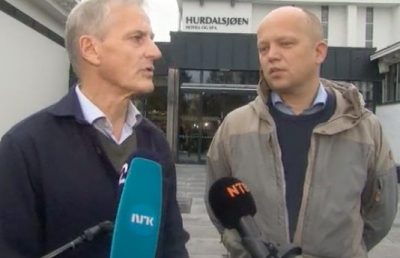Crises often bring people together and boost support for their government, but that’s not happening in Norway. Both the Labour and Center parties have tumbled once again in the latest public opinion poll, and they’re publicly at odds on several major issues.

Labour and Center form a minority left-center coalition that needs support from the Socialist Left Party (SV) for a majority in Parliament. All three dipped again in the latest poll conducted by research firm Norstat for state broadcaster NRK and newspaper Aftenposten.
Labour fell 1.7 percentage points, and now holds just 20.9 percent of the vote. That’s down from an election result last fall of 26.3 percent.
Center is a shadow of its former self, falling by more than half of its poll results a year ago to just 8.5 percent. Center’s poor performance also compares to election results in September of 13.5 percent, indicating it has lost more voters than most all the other parties.
SV lost the least, falling just 0.1 points to 7.8 percent, but leaving Prime Minister Jonas Gahr Støre with a much smaller hold on power. It would now depend not only on support from the Reds Party but also from the Greens.
There’s clearly been no positive effect from the Ukraine crisis on the government itself, even though all nine parties represented in Parliament stand firmly behind Ukraine. Støre, a career diplomat who’s always been strongest in the field of international relations, has few if any problems winning support for proposals to help Ukraine. If anything, he’s been criticized for responding too slowly, for example to Ukraine’s urgent need for weapons. On Wednesday, the entire Norwegian Parliament was likely to be the latest to give another standing ovation to the people of Ukraine, this time after President Volodymyr Zelensky was due to address them at 2pm.
It’s all the other domestic issues that seem to be dragging Støre’s government down, and dividing it internally.
“I think that when you have government responsibility at a time when folks are experiencing much more expensive electricity, more expensive food and that (fuel) prices at the pump go up and down, it’s not unusual that those sitting with responsibility get hit by that,” Støre told NRK.
Asked what it will take to win back voters, Støre pointed to “showing (good) results from our policies, and I think we’ll manage that. I’m optimistic about that.”
Climate collision
Just this week, though, his Labour Party and Center were on a collision course once again. They earlier failed to cooperate on reversing local government mergers they’d campaigned against. On Monday Center veteran Marit Arnstad, who leads the party’s delegation in Parliament, declared at the party’s national board meeting that the government should rather postpone its deadline for meeting its climate goals for emissions cuts than electrify offshore oil platforms with electricity from the mainland. With electricity rates already setting new records this past winter, rates could climb even higher if more supply is sent offshore.
“It’s about time to talk about the elephant in the room,” said Arnstad from the podium at the meeting of Center’s top politicians. That led to claims of a “power failure” within the government, not least after Labour quickly dismissed any effort to postpone climate goals. Commentator Hege Ulstein quickly noted how the energy crisis is sparking more problems within the government, while Center critics could point to how Center has never been known as particularly concerned about the climate. Most Center politicians object to high fuel prices and support Norway’s oil industry just as much as the right-wing Progress Party does.
‘Trygve, where are you?’
Center leader Vedum has also been roundly criticized in the media for being loud and clear while in opposition but now dodging questions and retreating on issues while in government. As finance minister he could lower or even remove all of Norway’s notoriously high taxes on fuel, other forms of energy or even consumer goods, but responds only that he and his government colleagues are “closely following” the recent sharp rise in monthly costs for households, businesses and industry. Political commentator Jo Moen Bredeveien wrote recently that “people don’t recognize the Center Party any longer, and its leader suddenly appears unfocused. Trygve, where are you?”
Labour has also had its problems in recent months, with poor polls, more infighting, Labour Minister Hadia Tajik’s dramatic resignation both from the government and as deputy party leader and an apparent attempted comeback by her party rival Trond Giske. He was famously dethroned during the Metoo crisis after being a target of multiple sexual harassment complaints. Now even young Labour MPs were being strongly criticized this week for deleting a portion of their own podcast that brought up the issue, indicating they’re still sweeping sexual harassment under the carpet, according to commentator Ulstein. They appeared more interested in teasing or berating other politicians than discussing serious issues of the day.
Conservative side closing in
Meanwhile, the Conservatives have re-emerged as Norway’s largest party, holding 27.3 percent of the vote in this week’s poll. That’s much bigger than Labour and a big jump from the 20.4 percent the Conservatives won in the last election.
Their former government partner, the Progress Party, also climbed 1.6 points to hold 12.5 percent of the vote, still well below levels at earlier elections but more than the 11.7 they won last September. Even the Christian Democrats gained in the latest poll, climbing to 4.6 percent in the new poll, comfortably over the 4 percent needed for full representation in Parliament.
The recently high-flying Reds suffered the biggest decline, down two full points to 6.9 percent and once again smaller than SV. The Greens climbed 0.8 points to 4.2 percent while the Liberals (which, despite their name, shared government power with the Conservatives) fell 0.2 points to 4.1 percent of the vote.
newsinenglish.no/Nina Berglund

